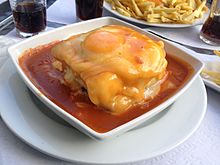Croque monsieur
 A croque monsieur | |
| Type | Sandwich |
|---|---|
| Place of origin | France |
| Serving temperature | Hot |
| Main ingredients | Bread, butter, ham (typically boiled), cheese (typically Gruyère), pepper and salt |
| Variations | Croque madame |
A croque monsieur (French pronunciation: [kʁɔk məsjø]) is a hot sandwich made with ham and cheese. The name comes from the French words croque ("crunch") and monsieur ("gentleman").
History
There are references to the dish before the end of the 19th century. In 1891, La Revue athlétique reported:
"It is late and we are very hungry. What should we do for lunch? Ham becomes monotonous in the long run. The Diplomat, who is a bit of a gourmand, and in this he resembles Talleyrand, has an idea. "Let's make croque-monsieur. Quickly, the toast, the butter, the Gruyère cheese, the ham, a little cayenne pepper and we are at work. One cuts, another butters, the third puts it all together into sandwiches that Vincent fries in the pan. They are exquisite, the croque-monsieur, a little big perhaps, made for the jaws of giants, but who cares? We eat them, we come back to them, we are delighted.[1]
In the early 1900s, bistro owner Michel Lunarca popularized the croque-monsieur.[2]
Preparation
A croque monsieur is traditionally made with baked or boiled ham and sliced cheese between slices of pain de mie, topped with grated cheese and slightly salted and peppered, and then baked in an oven or fried in a frying pan. The bread may optionally be browned by grilling after being dipped in beaten egg. Traditionally, Gruyère is used, but sometimes Comté or Emmental cheese as well. Some brasseries also add béchamel sauce.
Croque monsieur may be baked or fried so that the cheese topping melts and forms a crust.[3][4]
Variations
A croque monsieur served with a poached or lightly fried egg on top is known as a croque madame[5] (or, in parts of Normandy, as a croque-à-cheval). According to the Petit Robert dictionary, the name dates to around 1960. The name croque-mademoiselle is associated with its lighter, vegetarian version: made of the same bread, but with ordinary melting cheese, accompanied with chives, cucumber and lettuce.[3]
In the United Kingdom, a ham-and-cheese hot snack is called a toastie, and toastie makers are available to buy. In the United States, the Monte Cristo, a ham-and-cheese sandwich, often dipped in egg and fried, is popular fare in diners.[6]
Variants of the sandwich with substitutions or additional ingredients are given names modelled on the original croque-monsieur, for example:
| Name | Added ingredients | Reference |
|---|---|---|
| Barros Jarpa | Variation with same ingredients from Chilean cuisine | [7] |
| Barros Luco | Made with roast beef instead of ham | [7] |
| Croque provençal | Tomato | [8] |
| Croque auvergnat | Bleu d'Auvergne cheese | [9] |
| Croque norvégien | Smoked salmon instead of ham | [7] |
| Croque tartiflette | Sliced potatoes and Reblochon cheese | [8] |
| Croque bolognese / croque Boum-Boum | Bolognese sauce | |
| Croque señor | Tomato salsa | |
| Croque Hawaiian | Slice of pineapple | |
| Croque gagnet | Gouda cheese and andouille | [10] |
| Croque Madame | Fried egg | [7] |
| Croque monsieur with bechamel | Standard croque monsieur topped with bechamel sauce | [7] |
| Francesinha | Variation from Portuguese cuisine with steak, sausage, ham, melted cheese and beer sauce | [7] |
-
A croque madame
-
A croque provençal
-
A croque gagnet
-
Portuguese version from Porto, called "Francesinha".
German style croques

Since the mid 1970s, a preparation that differs significantly from the French croque variety has become established in northern Germany and is now widespread throughout Germany. The main difference in preparation is a baguette whose lower half is topped with salami, Ham, chicken or turkey strips, and topped with cheese. This is then garnished with other ingredients such as lettuce, coleslaw, onions, cucumber slices and tomatoes and various sauces such as mayonnaise, tartar sauce, garlic sauce, curry sauce or chilli sauce. The top half of the baguette, which is also baked, is placed on top.[11]
See also
References
- ^ "En wherry. Trois semaines dans les broads du Norfolk". Gallica (in French). La Revue athlétique. 1891-09-25. p. 541. Retrieved 2023-03-10.
- ^ "La savoureuse histoire du croque-monsieur". Le Figaro. 4 April 2019. Retrieved 4 April 2019.
- ^ a b "Croque-monsieur et croque-madame font des enfants" (in French). aufimin cuisine suisse. 18 March 2009. Retrieved 21 August 2015.
- ^ "Croque monsieur au four". Cuisine actuelle. Retrieved 21 August 2015.
- ^ Dictionnaire général pour la maîtrise de la langue française, la culture classique et contemporaine. Paris: Larousse. 1993. p. 405. ISBN 2-03-320300-X. OCLC 29916226.
- ^ "History of the Grilled Cheese Sandwich". History of the Grilled Cheese Sandwich. Archived from the original on 8 March 2021. Retrieved 6 February 2018.
- ^ a b c d e f Russo, Susan. The Encyclopedia of Sandwiches.
- ^ a b "All the Croque Monsieur Recipes You Will Ever Need". Archived from the original on 2016-10-20. Retrieved 2011-08-06.
- ^ Downie, David (23 July 2000). "Bread Winner". Los Angeles Times.
- ^ "Tracing the History of the Croque Monsieur Sandwich Paris Blog Oui Always Have Paris". Oui Always Have Paris. 2015-08-11. Retrieved 2018-10-06.
- ^ Thomas Röbke (October 1996). "Boque auf Croque: Vor zwanzig Jahren wurde der Croque erfunden – nicht etwa in Frankreich, sondern in Hamburg". Szene Hamburg (in German). Hamburger Stadtillustrierten-Verl.-Ges.: 38.





